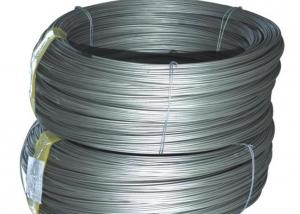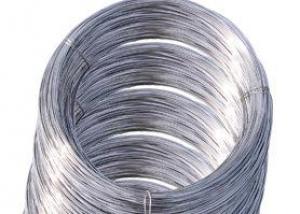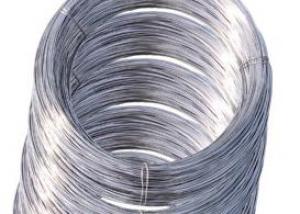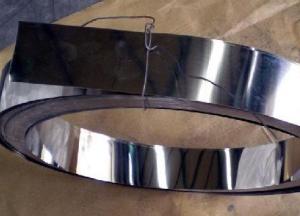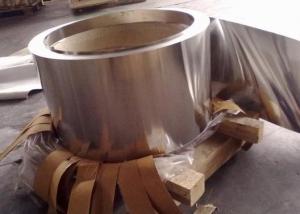wire mesh stainless steel in heavy duty
- Loading Port:
- Qingdao
- Payment Terms:
- TT OR LC
- Min Order Qty:
- 10 m.t.
- Supply Capability:
- 1000 m.t./month
OKorder Service Pledge
OKorder Financial Service
You Might Also Like
heavy duty wire mesh stainless steel
Chemical composition of stainless steel wire:
AISI Grade | Chemical Composition(%) | |||||||
| C | Si | Mn | P | S | Ni | Cr | Mo | |
| 304 | ≤0.08 | ≤1.00 | ≤2.00 | ≤0.045 | ≤0.030 | 8.00~10.50 | 18.00~20.00 | - |
| 304H | >0.08 | ≤1.00 | ≤2.00 | ≤0.045 | ≤0.030 | 8.00~10.50 | 18.00~20.00 | - |
| 304L | ≤0.030 | ≤1.00 | ≤2.00 | ≤0.045 | ≤0.030 | 9.00~13.50 | 18.00~20.00 | - |
| 316 | ≤0.045 | ≤1.00 | ≤2.00 | ≤0.045 | ≤0.030 | 10.00~14.00 | 10.00~18.00 | 2.00~3.00 |
| 316L | ≤0.030 | ≤1.00 | ≤2.00 | ≤0.045 | ≤0.030 | 12.00~15.00 | 16.00~18.00 | 2.00~3.00 |
| 430 | ≤0.12 | ≤0.75 | ≤1.00 | ≤0.040 | ≤0.030 | ≤0.60 | 16.00~18.00 | - |
| 430A | ≤0.06 | ≤0.50 | ≤0.50 | ≤0.030 | ≤0.50 | ≤0.25 | 14.00~17.00 | - |
Stainless Steel Hard Wire
Use: steel rope , steel brush, spring , stapler, etc.
Size: from 0.05mm to 5mm
Soft stianless steel wire
Use: Knitted wire mesh, weaving wire mesh, filtration mesh, high pressure pipe
Size: from 0.07mm -0.60mm
| Standard: | AISI,ASTM,DIN,EN,GB,JIS |
Deviation (mm) | Standard | |
Tolerance (mm) | Max.Deviation (mm) | |
0.32-0.45 | ±0.006 | ±0.006 |
0.50-0.75 | ±0.006 | ±0.006 |
0.80-0.95 | ±0.008 | ±0.008 |
1.00-1.25 | ±0.010 | ±0.010 |
1.30-1.50 | ±0.010 | ±0.010 |
1.60-1.80 | ±0.015 | ±0.015 |
2.0-2.5 | ±0.015 | ±0.015 |
3.0-4.0 | ±0.015 | ±0.015 |
- Q:What are the different types of stainless steel wire ropes used in mining?
- The mining industry utilizes various stainless steel wire ropes that are tailored for its demanding conditions and applications. These wire ropes are specifically engineered to withstand the harsh environment encountered in mining operations. Several types of stainless steel wire ropes commonly used in mining include: 1. 6x19 Class Wire Rope: Comprised of six strands, with each strand containing 19 wires, this wire rope strikes a balance between flexibility and strength. It is suitable for a range of mining applications like hoisting, hauling, and lifting. The 6x19 class wire rope is renowned for its resistance to wear and fatigue, making it reliable in rugged mining settings. 2. 6x36 Class Wire Rope: This wire rope consists of six outer strands, each containing 36 wires. It offers increased flexibility compared to the 6x19 class wire rope, making it ideal for applications that require enhanced bending capabilities. The 6x36 class wire rope is commonly employed in mining operations that involve heavy-duty lifting and dragging tasks. 3. 6x37 Class Wire Rope: Similar to the 6x36 class wire rope, this wire rope also consists of six outer strands. However, it contains 37 wires in each strand, providing even greater flexibility and resistance to fatigue. The 6x37 class wire rope is commonly used in mining applications that demand high strength and flexibility, such as deep shaft sinking and underground mining operations. 4. 8x19 Class Wire Rope: Composed of eight outer strands, with 19 wires in each strand, this wire rope offers improved resistance to wear and increased strength compared to the 6x19 class wire rope. It finds common use in mining applications involving heavy loads and high levels of abrasion, such as conveyor systems and material handling equipment. 5. 8x36 Class Wire Rope: Consisting of eight outer strands, with 36 wires in each strand, this wire rope excels in bending capabilities and resistance to fatigue. It is suitable for mining applications that require repetitive bending or flexing, like cranes, derricks, and winches used in mining equipment. These diverse stainless steel wire ropes employed in mining are purposefully designed to meet the specific demands of various mining applications. They offer superior strength, flexibility, and resistance to corrosion and wear, ensuring the safety and efficiency of mining operations.
- Q:What are the different types of stainless steel wire ties?
- There are several different types of stainless steel wire ties available, each with its own unique features and applications. 1. Self-locking wire ties: These ties have a built-in locking mechanism that allows for quick and secure installation. They are commonly used in automotive, aerospace, and electrical industries. 2. Releasable wire ties: As the name suggests, these ties can be easily released and reused, making them convenient for applications where frequent adjustments or modifications are required. 3. Coated wire ties: These ties are coated with materials such as nylon or PVC, which provide additional protection against corrosion, abrasion, and harsh environments. They are commonly used in outdoor or marine applications. 4. Stainless steel ladder ties: This type of tie features a ladder-like design, allowing for easy bundling and securing of cables or wires. They are often used in industrial and construction settings. 5. Ball-lock stainless steel ties: These ties have a unique ball-locking mechanism that provides high tensile strength and resistance to vibration. They are commonly used in heavy-duty applications and areas where extreme conditions are present. 6. Stainless steel cable ties with tags: These ties have an integrated tag or label holder, making them ideal for applications where identification or labeling of cables or wires is required. 7. Releasable metal ball-lock ties: These ties combine the strength and durability of stainless steel with the convenience of a releasable mechanism. They are commonly used in applications where frequent adjustments or replacements are necessary. Overall, the wide range of stainless steel wire ties available allows for flexibility and customization to suit various industries and applications.
- Q:Can stainless steel wire be used for medical implants?
- Yes, stainless steel wire can be used for medical implants. Stainless steel is commonly used in medical devices and implants due to its corrosion resistance and biocompatibility. It is used for a variety of applications such as orthopedic implants, surgical instruments, and cardiovascular devices.
- Q:What are the different types of stainless steel wire ropes slings?
- There are several types of stainless steel wire rope slings available, including single leg slings, double leg slings, basket slings, and endless slings. Each type is designed to serve specific lifting and rigging purposes, offering various configurations and capabilities for different applications.
- Q:Can stainless steel wire be used for filter screens?
- Filter screens can indeed utilize stainless steel wire. Stainless steel is renowned for its resistance to corrosion and its long-lasting nature, making it a highly suitable material for filters. The wire can be skillfully woven or welded into a mesh design, resulting in a robust and evenly distributed filter screen. Industries such as oil and gas, water treatment, food processing, and pharmaceuticals commonly employ stainless steel filter screens. These screens effectively capture and separate particles, debris, and impurities from both liquids and gases, guaranteeing an excellent level of filtration efficacy. Additionally, stainless steel wire screens can endure high temperatures and are effortless to clean and maintain, rendering them a dependable choice for filter applications.
- Q:Can stainless steel wire be used for strengthening concrete?
- Certainly! Stainless steel wire has the capability to enhance the strength of concrete. Given its exceptional resistance to corrosion, stainless steel wire proves to be an appropriate material for reinforcing concrete structures that encounter harsh surroundings or corrosive elements. Its remarkable tensile strength enables it to effectively combat the forces that impact the concrete, thereby reducing the likelihood of cracks and augmenting the structure's overall longevity. Depending on the project's specific demands, stainless steel wire can be employed in diverse forms, including bars, mesh, or fibers.
- Q:Can stainless steel wire be used for knitting needles?
- Yes, stainless steel wire can be used for knitting needles. Stainless steel is a durable and strong material that is resistant to rust and corrosion, making it an excellent choice for knitting needles. It provides a smooth surface that allows stitches to glide easily, resulting in a more enjoyable and efficient knitting experience. Additionally, stainless steel needles are less likely to break or bend compared to other materials, ensuring their longevity. However, it is important to note that stainless steel needles may feel colder to the touch than other materials, which could be a factor to consider depending on personal preference.
- Q:Can stainless steel wire be used for wire EDM machining?
- Indeed, wire EDM machining can utilize stainless steel wire. Wire EDM, a meticulous machining technique, employs a slender wire with electrical conductivity to sever a workpiece. Stainless steel wire is frequently favored for wire EDM machining due to its remarkable strength, resistance to corrosion, and exceptional conductivity. This wire can proficiently penetrate an array of materials, encompassing metals, alloys, and even hardened steels. Furthermore, stainless steel wire provides commendable stability, endurance, and dimensional precision, rendering it an appropriate selection for intricate and precise machining endeavors.
- Q:Can stainless steel wire be used for wire EDM cutting?
- Wire EDM cutting can utilize stainless steel wire for cutting through conductive materials with precision. Stainless steel wire is preferred due to its strength, corrosion resistance, and electrical conductivity. It is capable of effectively cutting through metals like steel, aluminum, titanium, and exotic alloys. By using stainless steel wire in wire EDM cutting, intricate shapes can be achieved with tight tolerances, making it a versatile option for manufacturing applications.
- Q:What are the different types of stainless steel wire ropes used in oil and gas exploration?
- There are several different types of stainless steel wire ropes that are commonly used in oil and gas exploration. These wire ropes are designed to withstand the extreme conditions and harsh environments that are often encountered in this industry. One type of stainless steel wire rope used in oil and gas exploration is the 6x19 construction. This type of wire rope consists of six strands, with each strand containing 19 individual wires. This construction provides a good balance between strength and flexibility, making it suitable for various applications in the industry. Another commonly used type is the 7x19 construction. As the name suggests, this wire rope consists of seven strands, with each strand containing 19 wires. This construction offers even greater flexibility than the 6x19 construction, making it ideal for applications that require a high degree of maneuverability. Additionally, the 8x19 construction is also used in oil and gas exploration. This wire rope consists of eight strands, with each strand containing 19 wires. The 8x19 construction provides excellent resistance to abrasion and fatigue, making it well-suited for demanding applications in the industry. Furthermore, the 6x36 construction is another type of stainless steel wire rope that finds use in oil and gas exploration. This wire rope is made up of six strands, with each strand containing 36 wires. The 6x36 construction offers superior breaking strength and resistance to bending fatigue, making it suitable for heavy-duty applications in the industry. Lastly, the 8x36 construction is also utilized in oil and gas exploration. This wire rope consists of eight strands, with each strand containing 36 wires. The 8x36 construction provides excellent resistance to crushing and bending fatigue, making it well-suited for applications that require high strength and durability. Overall, the different types of stainless steel wire ropes used in oil and gas exploration are chosen based on the specific requirements of the application, taking into consideration factors such as strength, flexibility, resistance to fatigue and abrasion, and the ability to withstand harsh environmental conditions.
1. Manufacturer Overview |
|
|---|---|
| Location | |
| Year Established | |
| Annual Output Value | |
| Main Markets | |
| Company Certifications | |
2. Manufacturer Certificates |
|
|---|---|
| a) Certification Name | |
| Range | |
| Reference | |
| Validity Period | |
3. Manufacturer Capability |
|
|---|---|
| a)Trade Capacity | |
| Nearest Port | |
| Export Percentage | |
| No.of Employees in Trade Department | |
| Language Spoken: | |
| b)Factory Information | |
| Factory Size: | |
| No. of Production Lines | |
| Contract Manufacturing | |
| Product Price Range | |
Send your message to us
wire mesh stainless steel in heavy duty
- Loading Port:
- Qingdao
- Payment Terms:
- TT OR LC
- Min Order Qty:
- 10 m.t.
- Supply Capability:
- 1000 m.t./month
OKorder Service Pledge
OKorder Financial Service
Similar products
New products
Hot products
Related keywords






















